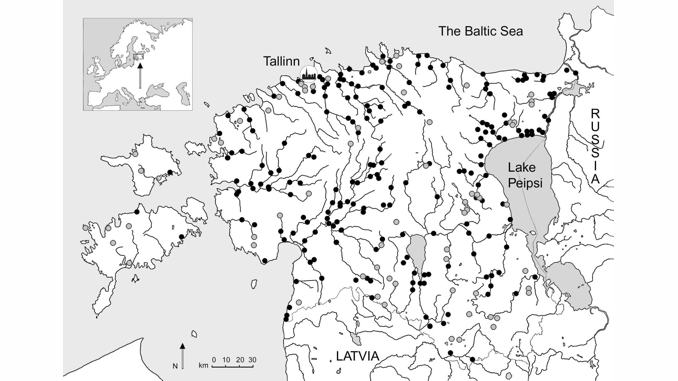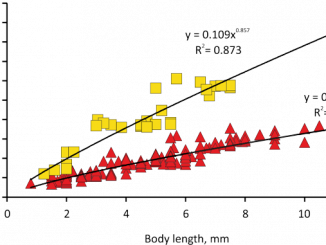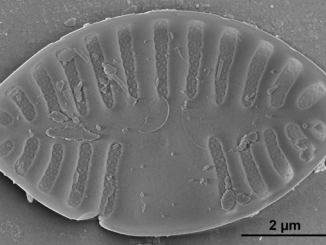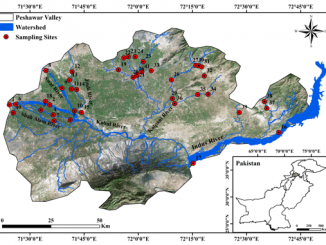
Paper category: Original research paper
Corresponding author: Henn Timm (henn.timm@emu.ee)
DOI: 10.2478/ohs-2019-0036
Received: 26/02/2019
Accepted: 09/04/2019
Full text: here
Citation (APA style): Timm, H. & Haldna, M. (2019). Do abundance and percentage of dipteran larvae and Oligochaeta indicate low water quality in streams and lake littoral?. Oceanological and Hydrobiological Studies, 48(4), pp. 415-429. Retrieved 10 Dec. 2019, from doi:10.2478/ohs-2019-0036
Abstract
The presence of chironomids and/or oligochaetes is generally considered to be an indication of poor status of freshwater. Non-chironomid dipterans show unclear trends. The abundance and percentage of these groups are rarely used as potential indicators. We attempted to determine whether these metrics reveal freshwater quality in lowland streams and lake littoral (Northern Europe, Baltic ecoregion, Estonia). The water quality was assessed based either on the water itself or on macroinvertebrates, fish, macrophytes, phytobenthos (in streams only) and/or phytoplankton (in lakes only). As expected, the high abundance and high percentage of chironomids and ceratopogonids indicated low quality of water in lakes. The high percentage of chironomids indicated low water quality also in streams. The high percentage of oligochaetes indicated low water quality in lakes. However, their high abundance (but not the percentage) was unexpectedly a symptom of high water quality in streams and to a lesser extent in lakes. In these cases, oligochaetes were represented by rheophilic, rather than saprophilic species. The abundance of simuliids (but not the percentage) and the richness of dipteran families indicated high water quality in streams. We suggest that the obtained results will allow better use of the indicative potential of freshwater macroinvertebrates.
References
Adriaenssens, V., Simons, F., Nguyen, L.T.H., Goddeeris, B., Goethals, P.L.M. et al. (2004). Potential of bio-indication of chironomid communities for assessment of running water quality in Flanders (Belgium). Belgian Journal of Zoology 134: 31–40.
Armitage, P.D., Moss, D., Wright, J.F. & Furse, M.T. (1983). The performance of a new biological water quality score system based on a wide range of unpolluted running-water sites. Water Research 17: 333–347.
Balian, E.V., Segers, H., Lévèque, C. & Martens, K. (2008). The freshwater animal diversity assessment: an overview of the results. Hydrobiologia 595: 627–637.
Blocksom, K.A., Kurtenbach, J.P., Klemm, D.J., Fulk, F.A. & Cormier, S.M. (2002). Development and evaluation of the Lake Macroinvertebrate Integrity Index (LMII) for New Jersey lakes and reservoirs. Environmental Monitoring and Assessment 77: 311–333.
Böhmer, J., Arbačiauskas, K., Benstead, R., Gabriels, W., Porst, G. et al. (2014). Central Baltic Lake Benthic invertebrate ecological assessment methods. Water Framework Directive Intercalibration Technical Report, Report EUR 26504 EN. Ed. by S. Poikane. European Commission Joint Research Centre, Institute for Environment and Sustainability.
Böhmer, J., Rawer-Jost, C., Zenker, A., Meier, C., Feld, C.K. et al. (2004). Assessing streams in Germany with benthic invertebrates: Development of a multimetric invertebrate based assessment system. Limnologica 34. 416–432.
Buffagni, A., Erba, S., Birk, S., Cazzola, M., Feld, C. et al. (2005). Towards European inter-calibration for the Water Framework Directive: Procedures and examples for different river types from the E.C. project STAR. Rome, March 1005, Quaderni 123.
Canedo-Arguelles, M., Bogan, M.T., Lytle, D.A. & Prat, N. (2016). Are Chironomidae (Diptera) good indicators of water scarcity? Dryland streams as a case study. Ecological Indicators 71: 155–162.
Dahl, J. & Johnson, R.K. (2004). A multimetric macroinvertebrate index for detecting organic pollution of streams in southern Sweden. Archiv für Hydrobiologie 160: 487–513.
Davis, S., Golladay, S.W., Vellidis, G. & Pringle, C.M. (2003). Macroinvertebrate biomonitoring in intermittent coastal plain streams impacted by animal agriculture. Journal of Environmental Quality 32: 1036–1043.
DeShon, J.E. 1995. Development and application of the invertebrate community index (ICI). In W.S Davis & T.P. Simon (Eds.), Biological assessment and criteria: Tools for water resource planning and decision making (pp. 217–243). Boca Raton, Florida: Lewis Publishers.
Feld, C.K., Kiel, E. & Lautenschläger, M. (2002). The indication of morphological degradation of streams and rivers using Simuliidae. Limnologica 32: 273–288.
Ferrington, L.C. (2008). Global diversity of non-biting midges (Chironomidae; Insecta-Diptera) in freshwater. Hydrobiologia 595: 447–455.
Fore, L.S., Karr, J.R. & Wisseman, R.W. (1996). Assessing invertebrate responses to human activities: Evaluating alternative approaches. Journal of the North American Benthological Society 15: 212–231.
Gallardo, A. & Prenda, J. (1994). Influence of some environmental factors on the freshwater macroinvertebrates distribution in 2 adjacent river basins under Mediterranean climate. 1. Dipteran larvae (excepting Chironomids and Simuliids) as ecological indicators. Archiv Für Hydrobiologie 131: 435–447.
Goodnight, C.J. & Whitley, L. S. (1961). Oligochaetes as indicators of pollution. Proceedings of 15th Industrial Water Conference. Purdue University. Eng. Ext. Ser. 106: 139–142.
Estonian National Environment Monitoring Program. Retrieved February 22, 2019, from http://seire.keskkonnainfo.ee/ (In Estonian).
Johnson, R.K. (1999). Benthic macroinvertebrates. In T. Wiederholm (Ed.), Bedömningsgrunder för miljökvalitet. Sjöar och vattendrag. Bakgrundsrapport 2. Biologiska parametrar (pp. 85–166). Naturvårdsverket Förlag.
Klemm, D.J., Blocksom, K.A., Thoeny, W.T., Fulk, F.A., Herlihy, A.T. et al. (2002). Methods development and use of macroinvertebrates as indicators of ecological conditions for streams in the Mid-Atlantic Highlands Region. Environmental Monitoring and Assessment 78: 169–212.
Lang, C. (1998). Using oligochaetes to monitor the decrease of eutrophication: the 1982–1996 trend in Lake Geneva. Archiv für Hydrobiologie 141: 447–458.
Lang, C. (2000). Response of oligochaete (Tubificidae and Lumbriculidae) and Diptera (Chironomidae) communities to the decrease of phosphorus concentrations in Lake Geneva (Little Lake). Annales de Limnologie – International Journal of Limnology 36: 13–20.
Lenat, D.R. (1983). Chironomid taxa richness: natural variation and use in pollution assessment. Freshwater Invertebrate Biology 2: 192–198.
Lenat, D.R. (1988). Water quality assessment of streams using a qualitative collection method for benthic macroinvertebrates. Journal of North American Benthological Society 7: 222–233.
Lock, K., Adriaens, T. & Goethals, P. (2014). Effect of water quality on blackflies (Diptera: Simuliidae) in Flanders (Belgium). Limnologica 44: 58–65.
Lorenz, A., Kirchner, L. & Hering, D. (2004). ‘Electronic subsampling’ of macrobenthic samples: how many individuals are needed for a valid assessment result? Hydrobiologia 516: 299–312.
Martin, P., Martinez-Ansemil, E., Pinder, A., Timm, T. & Wetzel, M.J. (2008). Global diversity of oligochaetous clitellates ("Oligochaeta"; Clitellata) in freshwater. Hydrobiologia 595: 117–127.
Martins, R.T., Couceiro, S.R.M., Melo, A.S., Moreira, M.P. & Hamada, N. (2017). Effects of urbanization on stream benthic invertebrate communities in Central Amazon. Ecological Indicators 73: 480–491.
Marziali, L., Armanini, D.G., Cazzola, M., Erba, S., Toppi, E. et al. (2009). Responses of chironomid larvae (Insecta, Diptera) to ecological quality in Mediterranean river mesohabitats (South Italy). River Research and Applications 26: 1036–1051.
Medeiros, A.S. & Quinlan, R. (2011). The distribution of the Chironomidae (Insecta: Diptera) along multiple environmental gradients in lakes and ponds of the eastern Canadian Arctic. Canadian Journal of Fisheries and Aquatic Sciences 68: 1511–1527.
Mellon, C.D., Wipfli, M.S. & Li, J.L. (2008). Effects of forest fire on headwater stream macroinvertebrate communities in eastern Washington, U.S.A. Freshwater Biology 53: 2331–2343.
Parker, S.M. & Huryn, A.D. (2011). Effects of natural disturbance on stream communities: a habitat template analysis on arctic headwater streams. Freshwater Biology 56: 1342–1357.
Milner, A.M., Conn, S.C. & Brown, L.E. (2006). Persistence and stability of macroinvertebrate communities in streams of Denali National Park, Alaska: implications for biological monitoring. Freshwater Biology 51: 373–387.
Morais, M., Pinto, P., Guilherme, P., Rosado, J. & Antunes, I. (2004). Assessment of temporary streams: the robustness of metric and multimetric indices under different hydrological conditions. Hydrobiologia 516: 229–249.
Nijboer, R.C. & Schmidt-Kloiber, A. (2006). The effect of excluding taxa with low abundances of taxa with small distribution ranges on ecological assessment. In: R.C. Nijboer (Ed.), The myth of communities: determining ecological quality of surface waters using macroinvertebrate community patterns. Alterra Scientific Contributions 117: 57–84.
Nilsson, A.N. (1997). Aquatic insects of North Europe: A taxonomic handbook. Vol. 2. Diptera, Odonata. Apollo (Denmark).
Ofenböck, T., Moog, O., Gerritsen, J. & Barbour, M. (2004). A stressor specific multimetric approach for monitoring running waters in Austria using benthic macro-invertebrates. Hydrobiologia 516: 251–268.
Paine, G.H. & Gaufin, A.R. (1956). Aquatic Diptera as indicators of pollution in a midwestern stream. Ohio Journal of Science 56: 291–304.
Rabeni, C.F. & Wang, N. (2001). Bioassessment of streams using macroinvertebrates: Are the chironomidae necessary? Environmental Monitoring and Assessment 71: 177–185.
Rapid Bioassessment Protocols For Use in Streams and Rivers: Periphyton, Benthic, Macroinvertebrates, and Fish, 2nd Edition. EPA 841-B-99-002. Retrieved February 22, 2019, from http://www.water-research.net/index.php/macroinvertebrates.
Raukas, A. (1995). Estonian Nature. Tallinn, Valgus/Eesti Entsüklopeediakirjastus (In Estonian).
Rolauffs, P., Hering, D., Sommerhäuser, M., Rödiger, S. & Jähnig, S. (2003). Entwicklung eines leitbildorientierten Saprobienindexes für die biologische Flieβgewässerbewertung. Umweltbundesamt Texte 11/03: 1–137.
Romero, K.C., Del Rio, J.P., Villarreal, K.C., Anillo, J.C.C., Zarate, Z.P. et al. (2017). Lentic water quality characterization using macroinvertebrates as bioindicators: An adapted BMWP index. Ecological Indicators 72: 53–66.
Rosa, B., Jabour, F.V., Rodrigues, L.F.T., de Oliveira, G.S. & da Gama Alves, R. (2014). Chironomidae and Oligochaeta for water quality evaluation in an urban river in southeastern Brazil. Environmental Monitoring and Assessment 186: 7771–7779.
Ruse, L. (2002). Colonisation of gravel lakes by Chironomidae. Archiv für Hydrobiologie 153: 391–407.
Saether, O.A. (1979). Chironomid communities as water quality indicators. Holarctic Ecology 2: 65–74.
Sandin, L. & Johnson, R.K. (2000). The statistical power of selected indicator metrics using macroinvertebrates for assessing acidification and eutrophication of running waters. Hydrobiologia 422: 233–243.
SAS Institute Inc. (2009). SAS Online Doc, version 9.2 SAS Institute Inc., Cary, NC, USA.
Seire, A. & Pall, P. (2000). Chironomid larvae (Diptera, Chironomidae) as indicators of water quality in Estonian streams. Proceedings of Estonian Academy of Sciences. Biology and Ecology 49: 307–316.
Serra, S.R.Q., Graca, M.A.S., Doledec, S. & Feio, M.J. (2017). Chironomidae traits and life history strategies as indicators of anthropogenic disturbance. Environmental Monitoring and Assessment 189: 326.
Skriver, J., Friberg, N. & Kirkegaard, J. (2000). Biological assessment of watercourse quality in Denmark: Introduction of the Danish Stream Fauna Index (DSFI) as the official biomonitoring method. Verhandlungen des Internationalen Verein Limnologie 27: 1822–1830.
Rapid Bioassessment Protocols For Use in Streams and Rivers: Periphyton, Benthic, Macroinvertebrates, and Fish, 2nd Edition. EPA 841-B-99-002. Retrieved February 22, 2019, from http://www.water-research.net/index.php/macroinvertebrates.
Status classes and class boundaries for surface water bodies and the procedure of classification (2010). Retrieved February 22, 2019, from https://www.riigiteataja.ee/akt/125112010015 (In Estonian).
Suemoto, T., Kawai, K. & Imabayashi, H. (2005). Dried-up zone as a temporal stock of chironomid larvae: survival periods and density in a reservoir bank. Hydrobiologia 545: 145–152.
Syrovátka, V. , Schenková, J. & Brabec, K. (2009). The distribution of chironomid larvae and oligochaetes within a stony-bottomed river stretch: the role of substrate and hydraulic characteristics. Fundamental and Applied Limnology 174/1: 43–62.
Timm, H., Käiro, K., Möls, T. & Virro, T. (2011). An index to assess hydromorphological quality of Estonian surface waters based on macroinvertebrate taxonomic composition. Limnologica 41: 398–410.
Timm, H., Möls, T. & Timm, T. (2006). Effects of long-term non-point eutrophication on the abundance and biomass of macrozoobenthos in small lakes of Estonia. Proceedings of Estonian Academy of Sciences. Biology and Ecology 55: 187–198.
Timm, T. (2009). A guide to the freshwater Oligochaeta and Polychaeta of Northern and Central Europe. Lauterbornia (International Journal of Faunistics and Floristics of European Inland Waters) 66: 235 pp.
Timm, T., Seire, A. & Pall, P. (2001). Half a century of oligochaete research in Estonian running waters. Hydrobiologia 463: 223–234.
Verdonschot, P.F.M. (2006). Beyond masses and blooms: the indicative value of oligochaetes. Hydrobiologia 564: 127–142.
Water Framework Directive (2000). The European Parliament and the Council of the European Union. Directive 2000/60/EC.
Water quality – Guidelines for the selection of sampling methods and devices for benthic macroinvertebrates in fresh waters (ISO 10870:2012).
Wazbinski, K.E. & Quinlan, R. (2013). Midge (Chironomidae, Chaoboridae, Ceratopogonidae) assemblages and their relationship with biological and physicochemical variables in shallow, polymictic lakes. Freshwater Biology 58: 2464–2480.
Wiederholm T. (1984). Responses of aquatic insects to environmental pollution. In: V.H. Resh & D.M. Rosenberg (Eds.), The ecology of aquatic insects (508–557). Chapman & Hall.




Be the first to comment